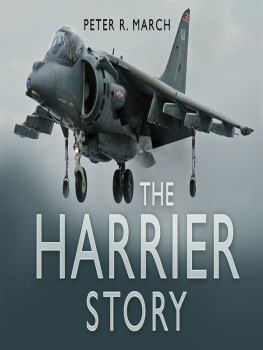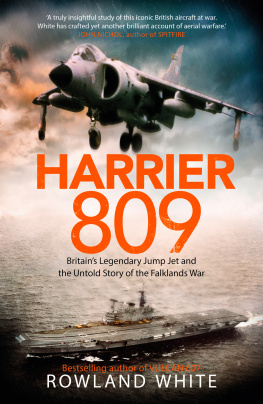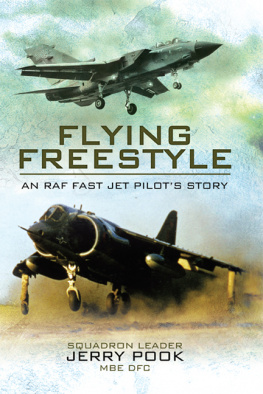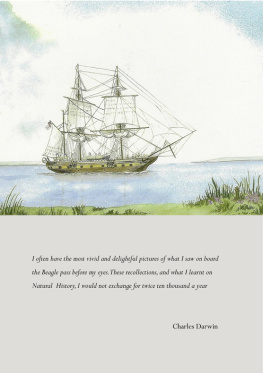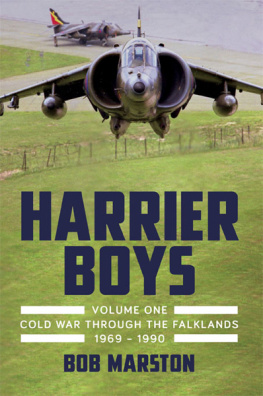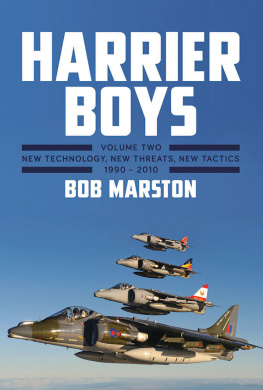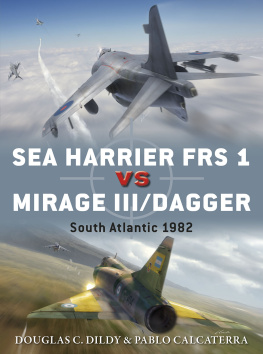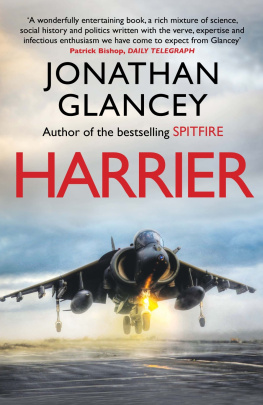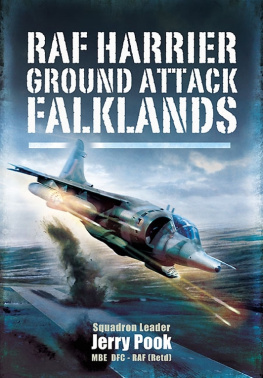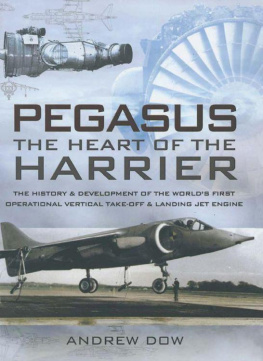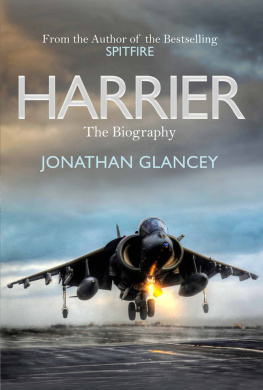The Harrier
Story
Peter R. March
First published in 2007 by Sutton Publishing Limited
The History Press
The Mill, Brimscombe Port
Stroud, Gloucestershire, GL5 2QG
www.thehistorypress.co.uk
This ebook edition first published in 2014
All rights reserved
Peter R. March, 2012, 2014
Peter R. March has asserted the moral right to be identified as the author of this work.
This ebook is copyright material and must not be copied, reproduced, transferred, distributed, leased, licensed or publicly performed or used in any way except as specifically permitted in writing by the publishers, as allowed under the terms and conditions under which it was purchased or as strictly permitted by applicable copyright law. Any unauthorised distribution or use of this text may be a direct infringement of the authors and publishers rights, and those responsible may be liable in law accordingly.
EPUB ISBN 978 0 7524 8506 5
MOBI ISBN 978 0 7524 8505 8
Original typesetting by The History Press
CONTENTS
ACKNOWLEDGEMENTS
T he story of the Harriers emergence from the drawing boards of the Bristol Aeroplane Companys Engine Division and Hawker Aircraft nearly fifty years ago, through to todays highly successful product from British Aerospace, McDonnell Douglas and Rolls-Royce, is long and complex. I am grateful to the authors of the many published references that have been used to compile this short narrative, and in particular Roy Braybrooks HarrierThe Vertical Reality published by Royal Air Force Benevolent Fund Enterprises in 1996.
I am indebted to some of the pioneers of V/STOL flight, who have allowed me to quote from their well-documented trials and tribulations, and Harrier test pilots Bill Bedford, John Farley and Duncan Simpson, who have provided colour to the story.
INTRODUCTION
I n a press release dated 25 November 1960, Hawker Aircraft confirmed the existence of a revolutionary new military aircraft that promised to combine the unique take-off and landing ability of the helicopter with the conventional performance of a jet fighter.
The resulting P.1127/Harrier family of vertical/short take-off and landing (V/STOL) combat aircraft, and the Rolls-Royce Pegasus series of vectored-thrust turbofans, together formed one of Britains most important contributions to postwar military aviation technology. Rather than using rotors or direct jet thrust, the P.1127 had an innovative vectored-thrust turbofan engine. It should also be remembered that the original powerplant concept was a derivative of a French invention, and that the aircraft would never have seen the light of day without substantial American support. The Harrier/Pegasus combination ultimately proved to be a very successful international product.
Everything we put up is rejected by either the RAF or Royal Navy and sometimes both.
Sir Sydney Camm, when designing the ill-fated P.1154, which was cancelled on 2 February 1965
Back more than half a century, the very fact that the P.1127s empty weight would decide whether or not the new aircraft could leave the ground by jet-lift alone, raised considerable doubt in peoples minds about the project. Hawker Aircraft had built its reputation on single-engined fighters, largely powered by Rolls-Royce engines, that looked superb and were highly manoeuvrable, but were by no means lightweight. The ultimate Hawker fighter was the solid and reliable Hunter, powered by a Rolls-Royce Avon turbojet, which had a good performance and a long-lasting airframe, and sold in large numbers.
Did you know?
In the early 1960s a former Chief of the Air Staff said: The Press ought to be told that such a machine is a toy, and quite useless for operational reasons.
The P.1127 was clearly not going to be a Hunter replacement over a wide range of combat roles. Its marketability was completely unknown and unpredictable, although it was clear from the outset that installing twice the thrust of a conventional ground attack aircraft would not make for a low-cost aircraft. Developing the Harrier family represented a significant break for Hawker away from multi-role conventional fighters.
More than forty years later, the Harrier, albeit in significantly different versions, is still very much in active service with the Royal Air Force, the US Marine Corps and the navies of India, Spain and Thailand. Produced by the successor companies Hawker Siddeley, British Aircraft Corporation, British Aerospace and BAE Systems in the UK and McDonnell Douglas (now part of the Boeing empire) in the USA, the Harrier has proved its worth to Britain in the Falklands, Belize, Iraq, the Balkans and Afghanistan and to the US Marine Corps for carrier and land-based operations around the world, not least in the Middle East.
Through the first decade of the twenty-first century the British Aerospace/McDonnell Douglas Harrier family continues to be the worlds only high-performance V/STOL combat aircraft to see service on a significant scale, just as its Rolls-Royce Pegasus vectored-thrust turbofan remains the only series-built V/STOL engine.
EARLY V/STOL
A lthough V/STOL had its true origins in Germany during the Second World War the rocket-powered Bachem Ba 349 Natter (Adder) had made its first piloted flight in February 1945 practical progress had to wait until the 1950s, when jet engines were far more advanced and there was a stronger operational motivation.
The successful development of jet engines was, by the 1950s, producing powerplants with a thrust that was very much greater. This offered the possibility of aircraft that could take off vertically, thereby not requiring long, expensive and vulnerable runways.
Rolls-Royce developed the Thrust Measuring Rig (TMR), popularly known as the Flying Bedstead in 1953 to test this principle with two Nene turbojets, at that time one of the most powerful in the world. This was to discover whether jet-borne flight could be safely controlled by the pilot. A control system, devised in association with RAE Farnborough, used jet reaction from puffer jets carried on long outriggers and fed with high-pressure air bled from the engine compressors.
Tests with the Flying Bedstead, culminated in its first untethered flight on 3 August 1954, piloted by R.T. Shepherd. This showed that pilots could achieve stable hovering flight and paved the way for the development of the control system still used today on the Harrier. The machine is now preserved in the Science Museum, South Kensington.
One of the driving forces behind V/STOL development came from the USA, where the US Navy funded the Lockheed XFV-1 and Convair XFY-1 turboprop tailsitters, but these tests ceased in 1956. A third US tailsitter was the single-seat Ryan X-13 Vertijet. Powered by a 10,000lb (44.5kN) Rolls-Royce Avon turbojet it became the worlds first jet-powered VTOL research aircraft when it was flown on 10 December 1955. It featured a hook mounted beneath the forward fuselage from which it was suspended for take-off, and was launched from and recovered to a tilting platform. But the tailsitter was very limited, and attention increasingly turned to the flat-riser, which required less mental gymnastics from the pilot.
With a high-set delta-wing, the X-13 had no landing gear and was designed to take off vertically. Two prototypes were built and the first complete transition from vertical take-off to horizontal flight and a vertical landing was accomplished on 11 April 1957. The Vertijet proved to be successful and was at one time thought likely to form the basis for the projected XF-109 VTOL fighter for the USAF.

